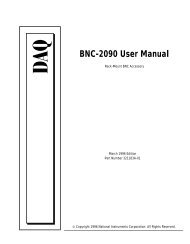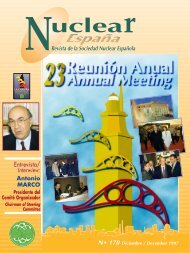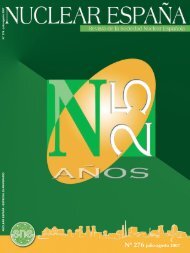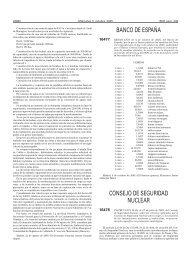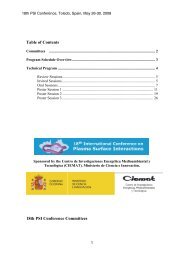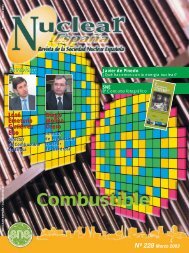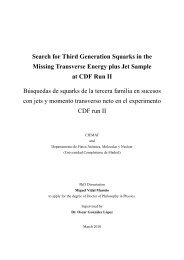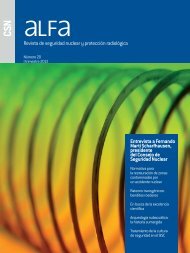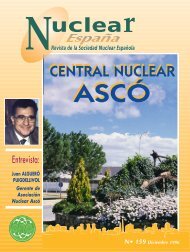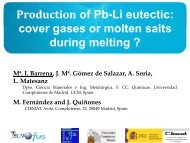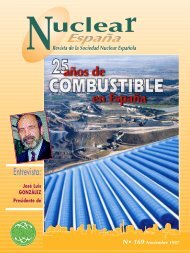EntrEntr evista/evista/ InterInter viewview
EntrEntr evista/evista/ InterInter viewview
EntrEntr evista/evista/ InterInter viewview
Create successful ePaper yourself
Turn your PDF publications into a flip-book with our unique Google optimized e-Paper software.
that is yielding results in the nuclear industry and that<br />
may contain elements that can be extrapolated to other<br />
industrial sectors.<br />
The importance attached by the nuclear arena to<br />
innovation, to technological research & development, is<br />
not new nor is it the legacy of any organization in<br />
particular, but it does demonstrate the consistency<br />
between its traditional approaches and the current idea<br />
of modernizing the country by promoting a national<br />
technological fabric.<br />
IDENTIFICATION AND DEVELOPMENT OF<br />
TECHNOLOGICAL INNOVATION PROJECTS<br />
The first step to innovating is to know what to do and<br />
for what purpose. Traditionally, terms such as business<br />
knowledge, market surveys and others have been used,<br />
and lately the concept of Technological Monitoring has<br />
become generalized. In any event, it is obvious that to<br />
define and implement innovative actions, an in-depth<br />
analysis of the environment in which the so-called<br />
innovation will be used is required.<br />
In the case that concerns us – nuclear R&D in Spain –<br />
the analysis results indicate that there has been a move<br />
from a regulated situation, in which an acceptable level<br />
of nuclear R&D activity was maintained with a welldefined<br />
organizational plan and with funding<br />
requirements basically covered, to a situation<br />
characterized by competition, organizational<br />
disintegration, funding problems and a slowdown of<br />
research activity that lately seems to be picking up.<br />
Of the trends observed, it should be noted that<br />
deregulation of the sector, modification of R&D funding<br />
conditions, and the need to increase competitiveness<br />
require a certain level of activity and that cooperative<br />
R&D offers advantages over other options, as it makes it<br />
possible to conduct the process in an organized way and<br />
to share risks and costs without detracting from each<br />
organization’s capacity for individual decision-making.<br />
The nuclear business has from the very beginning had<br />
an inevitable international component, and thus the<br />
analysis must seemingly be repeated for the international<br />
arena. In this respect, it should be noted that the sector<br />
has extensive experience in international R&D<br />
collaboration which, with the national technological<br />
level obtained, provides technological and funding<br />
possibilities (under certain conditions). In the current<br />
situation, these collaborations help to partially<br />
compensate for diminished activity by minimizing<br />
technological and economic risks.<br />
As regards the trends observed internationally, it<br />
should be noted that, while maintaining the progressive<br />
evolution of safety improvement, the economic efficiency<br />
factor has become key to maintaining the viability of the<br />
nuclear option on an international scale, thus<br />
overcoming the problems of a reticent public opinion.<br />
Therefore, there are strong motivations for international<br />
collaboration, provided that it targets this goal and results<br />
as much as possible in a practical application.<br />
The analysis summarized above leads to a simplified<br />
deduction of the relationship between technological<br />
innovation and competitiveness, which can be realized<br />
by defining certain courses of action in R&D.<br />
The new regulatory environment determines a clear<br />
orientation of R&D towards improved competitiveness<br />
of the nuclear option as a whole, in that the<br />
compatibility of this option with suitable safety<br />
conditions represents the basic framework of action.<br />
This improvement has obvious implications: extend<br />
power plant operational lifetime as much as possible,<br />
obtain the maximum possible output during this<br />
lifetime, and achieve tight operating margins.<br />
Because of progressive aging of the nuclear park,<br />
international operating experience, the investments<br />
made in large components, and the prospects for NPP<br />
lifetime extension, continuous attention must be paid to<br />
the identification, prediction and treatment of material<br />
degradation mechanisms, with particular attention to<br />
other components such as the vessel and internals.<br />
Within the broad framework of operation and<br />
maintenance, the initiatives will tend to reduce costs,<br />
de modernizar el país promocionando<br />
un tejido tecnológico nacional.<br />
LA IDENTIFICACIîN<br />
Y EL DESARROLLO<br />
DE PROYECTOS DE<br />
INNOVACIîN TECNOLîGICA<br />
El paso previo para innovar consiste<br />
en saber qué y para qué hacerlo.<br />
Tradicionalmente se ha hablado<br />
de conocimiento del<br />
negocio, de prospección de los<br />
mercados y de otros tantos términos,<br />
habiéndose generalizado últimamente<br />
el uso del concepto de<br />
Vigilancia Tecnológica. En cualquier<br />
caso, resulta claro que para<br />
definir y llevar a término actuaciones<br />
innovadoras se precisa realizar<br />
un análisis profundo del entorno<br />
en el que se desenvolverá la supuesta<br />
innovación.<br />
En el caso que nos ocupa, la I+D<br />
nuclear en España, el análisis arroja<br />
como resultados destacables<br />
que se ha pasado de una situación<br />
regulada, en la que se mantenía un<br />
nivel aceptable de actividad en<br />
I+D nuclear, con un esquema organizativo<br />
bastante definido y con<br />
unas necesidades de financiación<br />
básicamente cubiertas a otra, caracterizada<br />
por la competencia, la<br />
desagregación organizativa, la dificultad<br />
de financiación y por una<br />
ralentización de la actividad investigadora<br />
que últimamente parece<br />
activarse.<br />
De entre las tendencias observadas<br />
podría destacarse que la desregulación<br />
del sector, la modificación<br />
de las condiciones de<br />
financiación de la I+D y la necesidad<br />
de incrementar la competitividad<br />
demandan un cierto nivel de<br />
actividad y que la I+D cooperativa<br />
ofrece ventajas frente a otras opciones<br />
al permitir liderar el proceso<br />
de forma organizada y compartir<br />
riesgos y costes sin merma de la<br />
capacidad de decisión individual<br />
de cada organización.<br />
La actividad nuclear ha tenido<br />
desde sus orígenes un componente<br />
internacional insoslayable, por lo<br />
que parece obligado repetir el análisis<br />
para el entorno internacional.<br />
En este aspecto, cabe destacar que<br />
el sector posee una dilatada experiencia<br />
en colaboración internacional<br />
en I+D que, con el nivel tecnológico<br />
nacional alcanzado, ofrece<br />
posibilidades tecnológicas y de financiación<br />
(bajo ciertos condicionantes).<br />
En la situación actual, estas<br />
colaboraciones permiten paliar<br />
parcialmente el declive de actividad<br />
minimizando riesgos tecnológicos<br />
y económicos.<br />
Respecto de las tendencias observadas<br />
a nivel internacional cabe<br />
destacar que, manteniendo una<br />
evolución progresiva en la mejora<br />
de la seguridad, el factor de eficiencia<br />
económica se revela como<br />
clave para el mantenimiento de la<br />
viabilidad de la opción nuclear a<br />
escala internacional, superando así<br />
las dificultades de una opinión pública<br />
reticente. Por lo tanto, las colaboraciones<br />
internacionales encuentran<br />
una fuerte motivación<br />
siempre que se orienten a ese fin y<br />
desemboquen lo más cerca posible<br />
de la aplicación práctica.<br />
Del análisis resumido anterior<br />
ya se deduce de forma simplificada<br />
la relación entre innovación<br />
tecnológica y competitividad que<br />
se puede concretar formulando determinadas<br />
líneas de actuación en<br />
I+D.<br />
El nuevo entorno normativo determina<br />
una orientación clara de la<br />
I+D hacia una mejora de la competitividad<br />
de la opción nuclear en<br />
su conjunto, de modo que la compatibilización<br />
de ésta con unas<br />
condiciones de seguridad adecuadas,<br />
representa el marco básico de<br />
actuación. Esta mejora tiene implicaciones<br />
claras: extender al máximo<br />
la vida operacional de las<br />
plantas, obtener el máximo output<br />
posible durante esa vida y conseguir<br />
unos márgenes de explotación<br />
ajustados.<br />
El progresivo aumento de edad<br />
del parque, la experiencia internacional<br />
de operación, las inversiones<br />
realizadas en grandes componentes<br />
y las expectativas de<br />
alargamiento de vida de las<br />
CC.NN., obligan a prestar una<br />
atención continuada a la identificación,<br />
predicción y tratamiento<br />
de los mecanismos de degradación<br />
de materiales con un incremento<br />
de atención por otros componentes<br />
como la vasija y los internos.<br />
En el amplio marco de la operación<br />
y el mantenimiento, las iniciativas<br />
tenderán a reducir costes,<br />
dosis y residuos por un lado y, por<br />
otro, mejorar aspectos operativos<br />
de la planta, buscando el aumento<br />
de la producción de energía compatible<br />
con los requisitos de seguridad.<br />
La reducción de los costes<br />
de aprovisionamiento, la mejora<br />
de los sistemas de información de<br />
la planta, la optimización del mantenimiento<br />
y de las dosis operacionales,<br />
el desarrollo de nuevas técnicas<br />
de inspección y reparación y<br />
A b r i l 2 0 0 0<br />
R e v i s t a S N E




